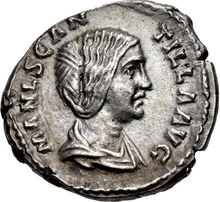This article includes a list of references, related reading, or external links, but its sources remain unclear because it lacks inline citations. (August 2023) |
Manlia Scantilla (fl. 193)[1] was a Roman woman who lived in the second century. She was very briefly Roman Empress as wife to the Roman emperor Didius Julianus.[2] Her name indicates that she was born into the gens Manlia, which if correct, indicates an illustrious patrician ancestry.
| Manlia Scantilla | |||||||||
|---|---|---|---|---|---|---|---|---|---|
| Augusta | |||||||||
 Coin featuring Manlia Scantilla | |||||||||
| Roman empress | |||||||||
| Tenure | Three months in 193 | ||||||||
| Spouse | Emperor Didius Julianus | ||||||||
| Issue | Didia Clara | ||||||||
| |||||||||
Manlia Scantilla married the senator Didius Julianus before his succession. Around 153, she bore Julianus a daughter and only child, Didia Clara, who was known for her beauty.
Her husband became emperor on 28 March 193 (known as "Year of the Five Emperors").[3] On that day, Scantilla and her daughter were awarded the title of Augusta by decree of the Roman Senate.[4] Scantilla enjoyed her title and status for less than three months because Julianus was killed on 1 June 193. The new emperor, Septimius Severus, removed her status and title as Augusta, but gave Scantilla and her daughter the former emperor's body for burial.[5][6] The two women buried Julianus in a tomb alongside his great-grandfather, outside of Rome. Within a month of Severus' accession to the throne, Scantilla died in obscurity. The fate of Didia Clara is unknown.
References
edit- ^ Woodward, A. M. (1961). "The Coinage of Didius Julianus and His Family". The Numismatic Chronicle and Journal of the Royal Numismatic Society. 1: 71–90. JSTOR 42662307.
- ^ "Thursday, May 12th, 1887". Proceedings of the Society of Antiquaries of London. 11: 395–401. June 1887. doi:10.1017/S0950797300008362.
- ^ Kleiner, Diana E. E. (1981). "Second-Century Mythological Portraiture : Mars and Venus". Latomus. 40 (3): 512–544. JSTOR 41532142.
- ^ Wagner, Cherryl Ann (1969). The biography of Didius Julianus in the 'Historia Augusta' (Thesis). OCLC 495464031. ProQuest 302414700.[page needed]
- ^ Varner, Eric R. (2001). "Portraits, Plots, and Politics: 'Damnatio memoriae' and the Images of Imperial Women". Memoirs of the American Academy in Rome. 46: 41–93. doi:10.2307/4238780. JSTOR 4238780.
- ^ Varner, Eric R. (2004). "The Severans A.D. 193–235". Mutilation and Transformation. pp. 156–199. doi:10.1163/9789047404705_010. ISBN 978-90-474-0470-5. S2CID 244740239.